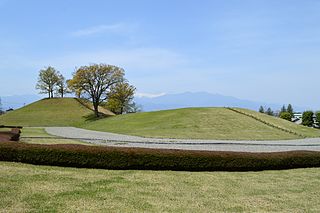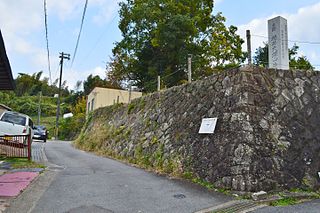
The Yayoi period started in the late Neolithic period in Japan, continued through the Bronze Age, and towards its end crossed into the Iron Age.

Wei (220–266), known as Cao Wei (曹魏) or Former Wei in historiography, was a dynastic state of China and one of the three major states that competed for supremacy over China in the Three Kingdoms period. With its capital initially located at Xuchang, and thereafter Luoyang, the state was established by Cao Pi in 220, based upon the foundations laid by his father, Cao Cao, towards the end of the Eastern Han dynasty.
Himiko, also known as Shingi Waō, was a shamaness-queen of Yamatai-koku in Wakoku (倭国). Early Chinese dynastic histories chronicle tributary relations between Queen Himiko and the Cao Wei Kingdom (220–265) and record that the Yayoi period people chose her as ruler following decades of warfare among the kings of Wa. Early Japanese histories do not mention Himiko, but historians associate her with legendary figures such as Empress Consort Jingū, who is said to have served as regent from 201 to 269.
Xiahou Mao, courtesy name Zilin, was a military general and marquis of the state of Cao Wei during the Three Kingdoms period of China. He was the second son of Xiahou Dun, a general who served under the warlord Cao Cao, while Xiahou Mao was a close friend of the founding Emperor Cao Pi. Xiahou Mao married Princess Qinghe, one of Cao Cao's daughters, though the marriage would be an unhappy one and he once faced accusation of treason from his own family.
Yamatai or Yamatai-koku(邪馬台国)(c. 1st century –c. 3rd century) is the Sino-Japanese name of an ancient country in Wa (Japan) during the late Yayoi period (c. 1,000 BCE –c. 300 CE). The Chinese text Records of the Three Kingdoms first recorded the name as (邪馬臺) or (邪馬壹) followed by the character 國 for "country", describing the place as the domain of Priest-Queen Himiko (卑弥呼). Generations of Japanese historians, linguists, and archeologists have debated where Yamatai was located and whether it was related to the later Yamato (大和国).

The Chinese magic mirror traces back to at least the 5th century, although their existence during the Han dynasty has been claimed. The mirrors were made out of solid bronze. The front was polished and could be used as a mirror, while the back has a design cast in the bronze, or other decoration. When sunlight or other bright light shines onto the mirror, the mirror appears to become transparent. If that light is reflected from the mirror onto a wall, the pattern on the back of the mirror is then projected onto the wall.
The Civil War of Wa or Great Rebellion of Wa was a period of disturbances and warfare in ancient Japan (Wa) during the late Yayoi period. It is the oldest war in Japan that has been documented in writing. Peace was restored around 180, when the shaman queen Himiko (Pimiko) of Yamatai-koku took control of the region.
Toyo (臺與/台与), also known as Iyo (壹與/壱与), (235–?) was a queen regnant of Yamatai-koku in Japan. She was, according to the "Records of Wei" and other traditional sources, the successor of Queen Himiko.

The Teradani Chōshizuka Kofun (寺谷銚子塚古墳) is a kofun burial mound located in the Teradani neighborhood of the city of Iwata, Shizuoka in the Tōkai region of Japan. The site was designated a National Historic Site of Japan in 1956, with the area under protection enlarged in 1979.

The Kai Chōshizuka Kofun (甲斐銚子塚古墳) is a kofun burial mound located in the Shimosone neighborhood of the city of Kōfu, Yamanashi in the Chūbu region of Japan. Together with the adjacent Maruyamazuka Kofun (丸山塚古墳) it was designated as a National Historic Site of Japan in 1930. It is one of the largest keyhole-shaped tumuli in eastern Japan and has a total length of 169 meters. The tumuli are located a three minute walk from the "Kenritsukōkohakubutsukan" bus stop on the Yamanashi Kōtsu Kankō Bus from Kōfu Station.

The Yamato Kingship was a tribal alliance centered on the Yamato region from the 4th century to the 7th century, and ruled over the alliance of noble families in the central and western parts of the Japanese archipelago. The age is from the 4th to the 7th century, later than the Yamatai Kingdom. After the Taika Reform, the ōkimi as an emperor, at that time, was in power, and the Yamato period ended. The time period is archaeologically known as the Kofun period. Regarding its establishment, due to the relationship between Yamatai and Yamato's succession to the king's power, there are very different views on it.
Ōkimi, or Ame no shita Siroshimesu Ōkimi, was the title of the head of the Yamato Kingship, or the monarch title of Wakoku. This term was used from the Kofun period through the Asuka period in ancient Japan.

Izumi Koganezuka Kofun (和泉黄金塚古墳) is a Kofun period keyhole-shaped burial mound, located in the Uedai neighborhood of the city of Izumi, Osaka in the Kansai region of Japan. The tumulus was designated a National Historic Site of Japan in 2008. It is noted for the bronze mirrors found within. These and other artifacts excavated from the tumulus are collectively designated a National Important Cultural Property.

The Wajinden are passages in the 30th fascicle of the Chinese history chronicle Records of the Three Kingdoms that talk about the Wa people, who would later be known as the Japanese people. It describes the mores, geography, and other aspects of the Wa, the people and inhabitants of the Japanese archipelago at the time. The Records of the Three Kingdoms was written by Chen Shou of the Western Jin dynasty at the end of the 3rd century.

The Ichinomiya Sengen Jinja (一宮浅間神社) is a Shintō shrine in the Takata neighborhood of the town of Ichikawamisato, Nishiyatsushiro District in Yamanashi Prefecture, Japan. It is one of two shrines which vie for the title of ichinomiya of the former Kai Province. The main festival of the shrine is held annually on November 3. It is also known as simply the Ichikawa Ichinomiya (市川一の宮) or the Ichinomiya Myōjin (一ノ宮明神) or the Ichinomiya Asama Jinja.

Ito-koku (伊都国) is one of the countries in Wa-koku, which appears in Chinese historical books such as Wajinden. It is said to be located 500 ri southeast of Matsurokoku, in the Yamato era, in the Prefecture of Ito, now Fukuoka Prefecture Itoshima City and part of Fukuoka City.

A large inward-looking flower mirror is a type of copper mirror.

Nishimotomezuka Kofun (西求女塚古墳) is a Kofun period burial mound, located in the Miyakodori, neighborhood of Nada-ku, Kobe, Hyōgo Prefecture, in the Kansai region of Japan. The tumulus was designated a National Historic Site of Japan in 2005.

Tsubai Ōtsukayama Kofun (椿井大塚山古墳) is a Kofun period keyhole-shaped burial mound, located in the Yamashiro neighborhood of the city of Kizugawa, Kyoto in the Kansai region of Japan. The tumulus was designated a National Historic Site of Japan in 2008. It is noted for the bronze mirrors which were found within. These artifacts are collectively designated a National Important Cultural Property.

Rei-kyō is an ancient type of Japanese round bronze mirror made in the late Kofun period. The mirror is named so because it has bells around its perimeter.














